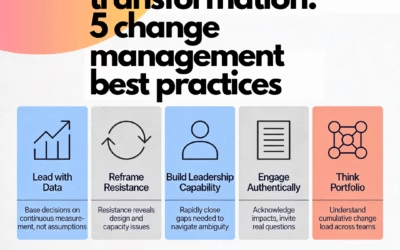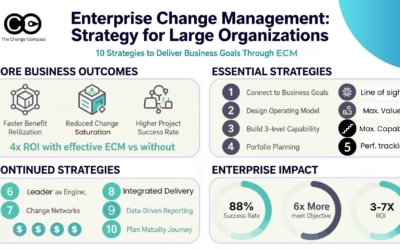What is enterprise change management?
Enterprise change management represents a fundamental evolution beyond traditional project-based change approaches. Rather than treating change as a series of isolated initiatives, enterprise change management (ECM) establishes systematic change capability across the entire organisation. According to Prosci’s research, ECM is defined as “the systematic deployment of change management skills, tools and processes throughout an organisation”. Beyond this limited interpretation, ECM is about embedding a system of change capabilities across the organisation to achieve business results.
This strategic approach transforms how organisations build, deploy, and sustain change capability. Unlike project-level change management that focuses on specific initiatives, ECM creates an organisational competency that enables rapid, effective response to changing business conditions whilst maintaining operational performance.
The core distinction lies in scope and integration. Traditional change management applies methodologies to individual projects or departments. Enterprise change management, however, embeds change capability into the organisational fabric itself, creating what researchers describe as “a strategic capability that enables the organisation to be agile, change ready and responsive to marketplace changes”.
The three levels of enterprise change capability
ECM operates across three integrated levels, each requiring different capabilities and governance structures. Research shows that organisations achieve sustainable transformation when they address all three levels systematically.
Individual level focuses on building personal change competency throughout the workforce. This means employees at all levels develop skills in navigating uncertainty, adapting to new processes, and contributing positively to transformation efforts. The goal is creating a change-ready workforce rather than relying on external change resources for each initiative.
Project level applies structured change management to specific initiatives whilst connecting them to broader organisational capabilities. Rather than treating each project as completely distinct, mature organisations leverage shared frameworks, common language, and integrated measurement systems that compound effectiveness across initiatives.
Enterprise level represents the systematic integration of change capability into organisational strategy, culture, and operations. At this level, change management becomes a core business competency that enables strategic agility and competitive advantage.
How enterprise change management differs from traditional approaches
The differences between traditional project-based change management and enterprise approaches are substantial and measurable. Traditional change management focuses on specific projects or departments, often operating in isolation with limited coordination across initiatives. The Project Management Office (PMO) may coordinate initiatives from a project resourcing or technical release perspective, but not from a people change perspective.
Scope of influence represents the most significant difference. Project-level change management targets only those directly impacted by a specific initiative, using output-based indicators like training completion rates or survey participation. Enterprise change management, however, builds organisational capability that scales across multiple initiatives simultaneously.
Strategic integration distinguishes mature ECM approaches from tactical project applications. Research from APMG International shows that ECM aligns all change initiatives with strategic goals, ensuring consistency and reducing confusion whilst increasing efficiency. This contrasts with project-specific approaches where different initiatives may define value differently, creating inconsistent outcomes.
Sustainability and learning transfer become possible only through enterprise approaches. Traditional project-based change management typically loses capability when projects end, requiring organisations to rebuild change capacity repeatedly. ECM creates persistent organisational learning that compounds across initiatives.
The research is clear about the performance implications. According to studies of enterprise versus traditional approaches, organisations implementing ECM report significantly higher success rates because “being a model that surrounds and sustains individual projects by ‘wrapping’ them into an organisation-wide view, ECM enables that aspect of change that is sometimes missing in other approaches: growth of the change capability itself”.
The three dimensions of enterprise change management
Effective ECM requires development across three interconnected dimensions, each contributing to overall organisational change capability.
Consistency involves applying common change management methods across all projects and initiatives. This creates organisational efficiency by eliminating the need to repeatedly train people on different methodologies, using the same language to avoid confusion and more effective from a capability development perspective. More importantly, consistency enables coordination across concurrent changes, reducing conflicts and competing demands on stakeholders.
Competency focuses on building and strengthening change management skills at every organisational level. This goes beyond training programs to encompass leadership competency from supervisors to senior executives. Research shows that sustainable ECM requires “a leadership competency at all levels of the organisation”, not just designated change professionals.
Strategic capability elevates change management to a key competency within business strategy itself. At this level, change management becomes integral to how the organisation plans, makes decisions, and executes strategic initiatives. This represents the most mature form of ECM, where change capability enables competitive advantage.
Why enterprise change management matters now
Today’s business environment demands more sophisticated approaches to managing change. Research indicates that organisations face unprecedented volumes of concurrent transformation initiatives, with 73% reporting being near, at, or beyond the point of change saturation. Traditional project-by-project approaches cannot effectively manage this complexity.
The velocity of change has also increased dramatically. Markets demand faster response to competitive threats and opportunities. Organisations with mature ECM capability can “respond more quickly to market dynamics because they don’t need to build change capacity from scratch for each new initiative”. They already have the frameworks, skills, and governance structures needed for rapid, effective transformation.
Competitive differentiation increasingly depends on change capability itself. McKinsey research shows that company-wide change efforts are 12.4 times more likely to be successful when senior managers communicate continually across the enterprise compared to project-specific communication approaches. This suggests that ECM becomes a source of sustainable competitive advantage.
The financial implications are substantial. Organisations with effective ECM report higher success rates, faster implementation timelines, and sustained adoption of new capabilities. As the Change Management Institute’s research demonstrates, building enterprise-wide change maturity enables organisations to achieve “level 3 or 4 of change management maturity, characterised by consistent approaches, embedded processes, application-focused learning, coaching support, and leadership-led change”.
Enterprise change management frameworks and processes
The Change Management Institute’s integrated approach
The Change Management Institute (CMI) has developed one of the most comprehensive frameworks for building enterprise change capability through their integrated approach to organisational change maturity. The CMI framework recognises that sustainable enterprise change management requires systematic development across three core domains that work together synergistically.
Project Change Management represents the foundation level, focusing on building consistent change management capability at the individual project level. This domain ensures organisations can effectively manage the people side of change for specific initiatives whilst building transferable skills and methodologies that scale across the enterprise.
Business Change Readiness addresses the organisational capability to anticipate, prepare for, and respond to change demands. This domain focuses on developing the cultural readiness, resource allocation, and strategic alignment necessary for sustained transformation capability.
Strategic Change Leadership represents the most mature level, where change management becomes integrated into strategic planning, decision-making, and organisational culture. At this level, change capability enables competitive advantage and strategic agility.
The CMI framework differs significantly from project-specific approaches because it explicitly builds organisational capability that persists beyond individual initiatives. Research shows that organisations achieving maturity across all three domains can respond more quickly to market dynamics because they don’t need to rebuild change capacity for each new initiative.
The CMI Change Practice Framework: a structured process approach
The Change Management Institute’s Change Practice Framework provides a practical process model for implementing enterprise change management through four integrated dimensions: Define, Analyse, Co-design, and Refine. This circular, iterative process ensures continuous improvement and adaptation whilst maintaining focus on sustainable outcomes.
Define establishes the vision for change, benefits mapping, change approach and roadmap, desired outcomes, and target timeframes. At the enterprise level, this phase ensures alignment between individual changes and broader organisational strategy whilst considering change portfolio impacts and resource allocation.
Analyse encompasses change impacts assessment, success indicators development, stakeholder identification, change maturity evaluation, change capability assessment, change readiness analysis, and determining the degree and scale of change required. This comprehensive analysis enables organisations to understand not just what needs to change, but the organisational capacity and capability required for success.
Co-design and Engage focuses on developing communication and engagement strategies, co-designed solutions, organisational redesign approaches, new ways of working, implementation planning, and risk mitigation strategies. The co-design approach ensures stakeholder involvement and ownership whilst building internal capability for future changes.
Align and Refine includes leadership coaching, tracking success criteria, real-time problem solving, testing and refining approaches, and organisational realignment activities. This phase ensures sustainable adoption whilst capturing learning that enhances future change capability.

Competency-based framework implementation
The CMI Change Manager Competency Models provide the foundation for building individual and organisational capability across three progressive levels: Foundation, Specialist, and Master. These models identify specific behavioural competencies required for success at each level, creating clear development pathways for building enterprise change capability.
Foundation level competencies focus on understanding change principles, supporting change implementation, and developing basic skills in impact assessment, communication, and project management. Foundation practitioners provide essential support whilst building capabilities that prepare them for more complex roles.
Specialist level competencies encompass strategic thinking, coaching for change, advanced influencing skills, and the ability to assess and respond to complex organisational dynamics. Specialist practitioners can lead change initiatives whilst contributing to broader organisational change capability development.
Master level competencies include advanced strategic thinking, organisational diagnosis, change leadership across multiple initiatives, and the ability to develop change capability in others. Master practitioners drive enterprise-wide change capability whilst influencing organisational culture and strategic decision-making.
The competency models address eleven core skill areas that span technical change management capabilities and interpersonal effectiveness skills. Research shows that organisations using competency-based approaches to building change capability achieve higher success rates and sustained adoption because they develop comprehensive capability rather than focusing solely on tools and processes.
Maturity-based progression framework
Enterprise change management requires systematic progression through defined maturity levels. The CMI framework aligns with broader industry recognition that organisations must develop through predictable stages to achieve sustainable change capability.
Level 1 maturity represents ad-hoc or absent change management where organisations apply change approaches reactively and inconsistently. Most organisations begin at this level, with change management applied only when projects encounter resistance or difficulties.
Level 2 maturity involves isolated project applications where change management is recognised as valuable but applied inconsistently across initiatives. Organisations at this level may achieve project-specific success but don’t build enterprise capability.
Level 3 maturity represents the beginning of enterprise approaches, with defined processes and consistent application across projects. Organisations at this level have established change management methodologies and are building internal capability systematically.
Level 4 maturity involves organisational standards where change management is embedded in project governance and business processes. Organisations achieve consistent application whilst building change leadership capability across multiple levels.
Level 5 maturity represents organisational competency where change management becomes part of organisational culture and strategic capability. At this level, change management enables sustained competitive advantage and strategic agility.
Integrating frameworks for enterprise implementation
Successful enterprise change management requires integration across multiple framework elements rather than applying individual components in isolation. The most effective implementations combine the CMI maturity progression with competency development and structured process application.
Governance integration connects change portfolio management with strategic planning cycles, ensuring change investments align with business priorities whilst maintaining organisational change capacity. This requires governance structures that can coordinate across multiple concurrent initiatives whilst building sustainable capability.
Learning integration ensures insights from individual changes enhance organisational capability rather than remaining project-specific knowledge. Mature organisations establish learning systems that capture and transfer change capability across initiatives and business units.
Cultural integration embeds change management principles into organisational culture, making change capability a shared competency rather than specialist expertise. This requires leadership development, communication strategies, and recognition systems that reinforce change-positive behaviours and capabilities.
Research demonstrates that organisations implementing integrated approaches achieve significantly higher success rates than those focusing on individual framework components. The integration enables compound benefits where each change initiative strengthens organisational capability for subsequent transformations.
Implementing enterprise change management: measurement, networks, and business integration
Measuring enterprise change management effectiveness
Successful enterprise change management requires structured measurement approaches that go beyond traditional project metrics. Unlike project-level success indicators such as training completion rates or survey scores, enterprise measurement focuses on organisational capability development, portfolio-level performance, and strategic impact on business outcomes.
Leading indicators of enterprise change capability include change readiness assessments across business units, change leadership competency scores, and business operational performance linked to change impacts. These predictive measures enable organisations to identify capability gaps before they impact transformation outcomes. Research shows that organisations tracking leading indicators achieve significantly higher success rates because they can address capability deficits proactively rather than reactively.
Portfolio-level metrics provide visibility into the collective impact of change initiatives rather than individual project success. These include change portfolio health scores, resource utilisation across concurrent changes, and stakeholder engagement effectiveness across multiple initiatives. Advanced organisations track change saturation levels, ensuring they don’t exceed organisational capacity to absorb transformation.
Business performance integration represents the most strategic measurement approach, connecting change management effectiveness directly to operational and financial outcomes. This includes metrics such as productivity maintenance during transformation, revenue impact from improved adoption rates, and competitive advantage gained through superior change capability. Academic research demonstrates that organisations integrating change metrics with business performance measurement achieve compound benefits from their transformation investments.
The key insight is that enterprise measurement requires different analytical frameworks than project-level assessment. Enterprise metrics focus on building sustainable capability rather than achieving specific deliverables, creating compound value that increases over successive transformations.
Building enterprise change champion networks
Enterprise change management success depends heavily on distributed leadership through structured change champion networks. Unlike traditional approaches that rely on designated change professionals, enterprise approaches develop change capability throughout the organisational structure, creating what researchers describe as “embedded change capacity”.
Strategic network design requires careful consideration of organisational structure, culture, and change demands. The most effective networks combine formal authority relationships with informal influence patterns, ensuring change champions have both positional credibility and peer respect across different organisational layers. Research shows that well-designed champion networks increase adoption rates by 15-25 percentage points.
Bi-directional communication channels enable both top-down strategic alignment and bottom-up insight gathering. Champion networks serve as early warning systems for emerging resistance, resource constraints, and implementation challenges. They also provide channels for sharing success stories and best practices across business units, creating organisational learning that compounds across initiatives.
Competency development within networks ensures change champions have the skills needed for success whilst building organisational capability for future changes. This includes training in change principles, coaching techniques, communication strategies, and problem-solving approaches. The Change Management Institute’s research emphasises that sustainable champion networks require structured competency development rather than relying solely on enthusiasm and goodwill.
Successful champion networks become self-reinforcing systems that strengthen with use. Each change initiative provides opportunities for champions to develop skills, build relationships, and enhance credibility, creating increasing capability for subsequent transformations.
Integrating change management with business operations
The most mature enterprise change management approaches seamlessly integrate change capability with standard business operations rather than treating change as separate organisational function. This integration creates sustainable capability whilst reducing the administrative overhead associated with parallel change management processes.
Business planning integration ensures change capacity planning becomes part of standard strategic and operational planning cycles. This includes assessing change demands during annual planning, allocating change resources based on business priorities, and sequencing initiatives to optimise organisational capacity utilisation. Research demonstrates that organisations integrating change planning with business planning achieve 20-30% better resource efficiency compared to separate planning approaches.
Performance management integration embeds change-related objectives and competencies into standard performance evaluation and development processes. This includes change leadership expectations for managers, change collaboration requirements for individual contributors, and change capability development objectives across all roles. Integration ensures change capability development receives ongoing attention rather than episodic focus during transformation initiatives.
Governance structure integration connects change portfolio management with strategic decision-making processes, ensuring change investments align with business priorities whilst maintaining organisational capacity for transformation. This requires governance bodies with authority to sequence changes, allocate resources, and escalate systemic issues that individual projects cannot resolve.
Real-world success through data-driven enterprise change management
Leading organisations are achieving measurable business value through a structured data-driven approaches to enterprise change management. The Change Compass platform exemplifies this evolution, enabling organisations to embed change management within general business management rather than treating it as separate organisational function. Case Study 4.
A major global financial services corporation transformed their approach to change management by integrating change metrics with standard business reporting. Within one year, they achieved remarkable results: leadership began prioritising change management as part of strategic oversight, business leaders increasingly requested proactive change support, and the organisation developed consistent change management practices across previously disconnected business units. Case Study 4.
The transformation occurred through strategic data integration rather than additional bureaucracy. By partnering with their Business Intelligence team and utilising Change Compass data capabilities, the corporation embedded change management insights into routine business tracking, making change visibility part of standard leadership decision-making processes.
The shift from “push” to “pull” model represents a fundamental change in how organisations approach change support. Rather than change teams offering services that business leaders may or may not utilise, leaders began actively seeking change management support as they recognised its impact on business performance. This cultural shift enhanced change management maturity across the enterprise whilst improving transformation outcomes. Case Study 2.
Enhanced decision-making through integrated reporting enabled leaders to understand the connection between change management effectiveness and business performance. By combining operational metrics with change management insights, executives could make more informed decisions about resource allocation, timing, and implementation approaches. The results included measurable improvements in project delivery timelines, reduced implementation costs, and sustained adoption of new capabilities.
Capability development through data insights became possible when organisations could track change management effectiveness over time and identify patterns that enhanced future performance. Rather than relying on subjective assessments or anecdotal evidence, mature organisations use data analytics to understand which change approaches work best in their specific context, enabling continuous improvement in change capability. Case Study 3.
The strategic value of integrated change management platforms
Modern enterprise change management requires sophisticated technology tools that can integrate with existing business systems whilst providing change-specific analytics and insights to augment what is currently missing. The Change Compass platform demonstrates how organisations can achieve enterprise change management maturity through strategic technology implementation rather than organisational restructuring.
Data integration capabilities enable organisations to connect change management metrics with business performance indicators, creating comprehensive dashboards that support strategic decision-making. This integration provides leaders with real-time visibility into change portfolio health, resource utilisation, and business impact, enabling proactive management rather than reactive problem-solving.
Predictive analytics for change planning help organisations anticipate change capacity requirements, identify potential resource conflicts, and optimise transformation sequencing. By analysing historical change data alongside business planning information, organisations can make more informed decisions about when to launch initiatives, how to allocate resources, and where to focus capability development efforts.
Competency tracking and development becomes systematic when organisations can monitor change management skills across the enterprise whilst identifying development needs and tracking progress over time. This creates targeted capability building that addresses specific organisational gaps rather than generic training approaches.
Building your enterprise change management capability
Enterprise change management represents one of the most significant opportunities for competitive advantage in today’s rapidly changing business environment. Organisations that build systematic change capability position themselves to respond more quickly to market dynamics, implement strategic initiatives more effectively, and sustain transformation outcomes over time.
The evidence is compelling: enterprise change management delivers measurable ROI through improved project success rates, reduced implementation costs, faster time-to-value, and sustained adoption of new capabilities. More importantly, organisations with mature change capability can pursue strategic opportunities that competitors cannot effectively implement.
The Change Compass platform empowers organisations to accelerate their journey toward enterprise change management maturity through data-driven insights, integrated measurement, and systematic capability development. The Change Compass enables transformation through strategic enhancement of existing processes and systems.
Leading organisations are already experiencing the benefits: enhanced leadership decision-making through integrated change and business metrics, improved resource efficiency through portfolio-level visibility, and sustained capability development through systematic tracking and analytics. These results create compound value that increases with each transformation initiative.
The opportunity for competitive advantage through superior change capability has never been greater. Market conditions demand rapid response to changing customer needs, competitive threats, and regulatory requirements. Organisations with enterprise change management capability can adapt faster, implement more effectively, and sustain transformation outcomes that create lasting competitive advantage.
Ready to transform your organisation’s change capability and start delivering measurable business value through enterprise change management? Discover how The Change Compass can help you build the data-driven change capability your organisation needs to thrive in today’s dynamic business environment.






